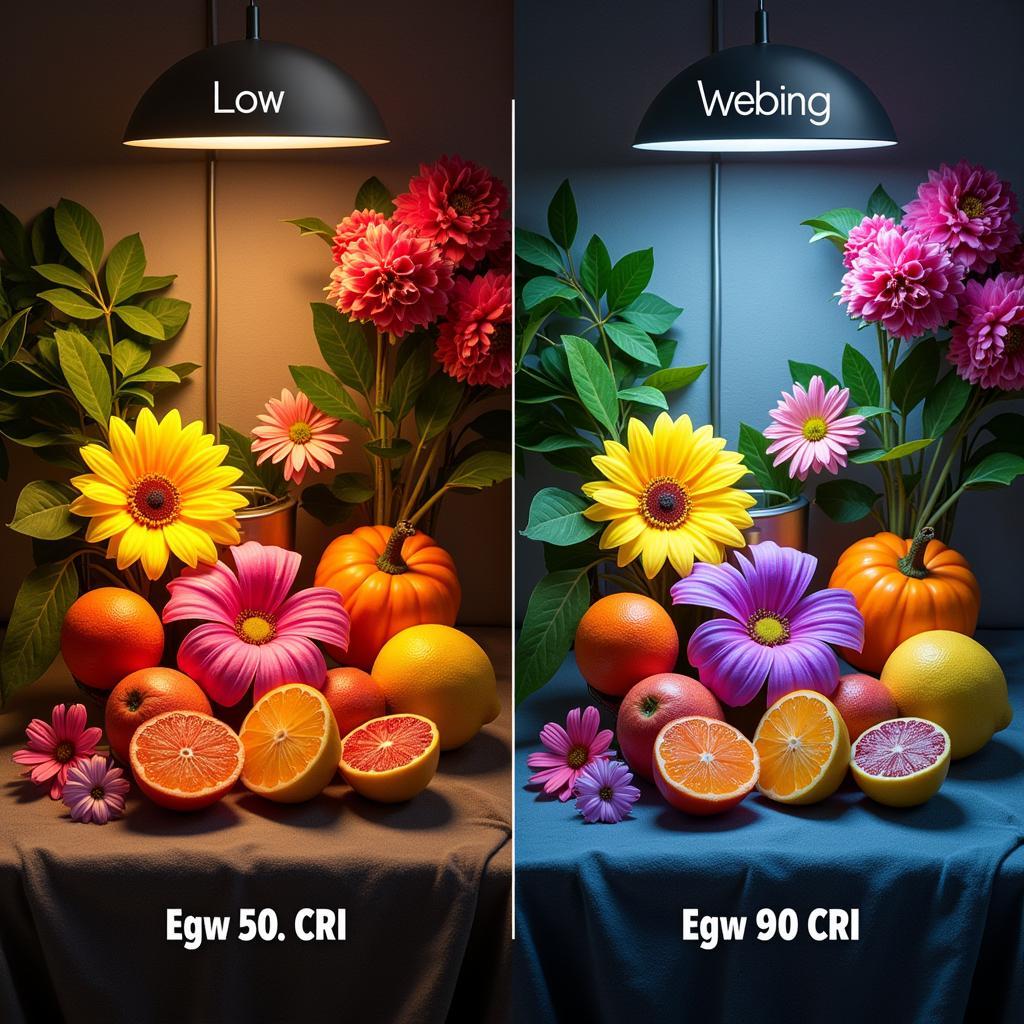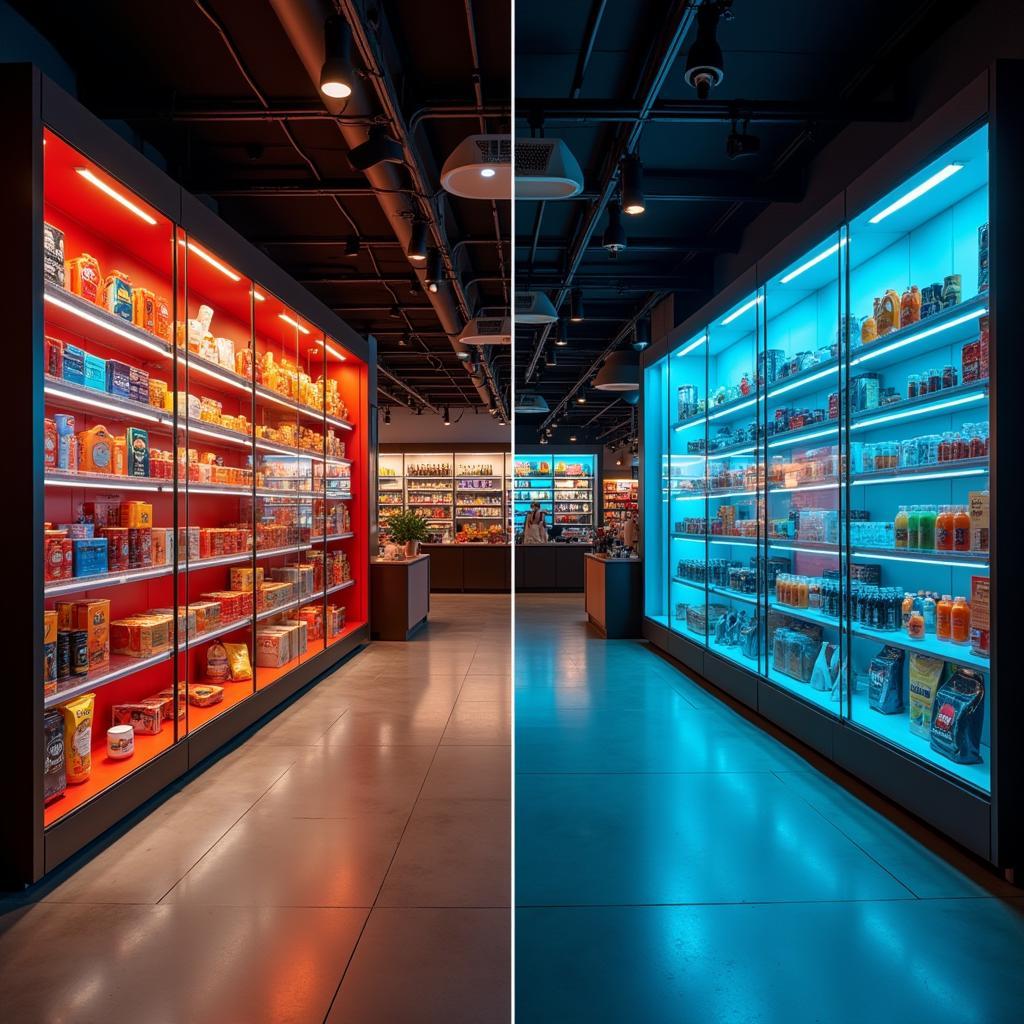Color rendering index (CRI) is a crucial factor when choosing lighting for your home or business. It measures how accurately a light source reveals the true colors of objects compared to a natural light source, like sunlight. Understanding CRI will help you create the perfect ambiance and showcase your space in its best light.
Understanding the Basics of CRI
CRI is expressed on a scale of 0 to 100. A CRI of 100 represents perfect color rendering, meaning colors appear as they would under a reference light source. Lower CRI values indicate that colors may appear distorted or washed out under the light source. Think of how some clothing can look completely different under store lighting versus natural daylight. That’s CRI at play!
How Does CRI Affect Our Perception of Color?
CRI significantly impacts how we perceive colors in our environment. High CRI lighting reveals the vibrant hues and subtle nuances of colors, making artwork, food, and even our skin tones look their best. Low CRI lighting, on the other hand, can make colors appear dull, flat, and lifeless. Imagine a beautiful red apple appearing slightly brown or orange under poor lighting. That’s the impact of a low CRI.
 Color Rendering Index Comparison Chart
Color Rendering Index Comparison Chart
Choosing the Right CRI for Different Spaces
The ideal CRI for a space depends on its purpose. For areas where accurate color perception is critical, such as art galleries, retail stores, or photography studios, a high CRI (90 or above) is essential. In homes, high CRI lighting is ideal for kitchens, bathrooms, and living areas where accurate color rendering enhances the ambiance and makes everyday activities more enjoyable. For less critical areas like garages or storage rooms, a lower CRI may be sufficient.
CRI in Residential Spaces
In your home, selecting the right CRI can transform the look and feel of each room. High CRI lighting in the kitchen makes food preparation more appealing, while in the living room, it enhances the colors of your furniture and decor, creating a welcoming atmosphere. A high CRI is especially beneficial in bedrooms and bathrooms, where accurate color rendering is important for makeup application and getting ready in the morning.
CRI in Commercial Applications
In commercial spaces, CRI is often a key consideration. Retail stores use high CRI lighting to showcase their merchandise in the most attractive light, encouraging sales. Restaurants benefit from high CRI lighting that makes food look more appetizing. Offices and other workspaces can also benefit from high CRI lighting, which can improve mood and productivity.
 The Impact of CRI on Retail Displays
The Impact of CRI on Retail Displays
What about LED Lighting and CRI?
LED lighting has revolutionized the lighting industry, offering energy efficiency and long lifespans. However, not all LEDs are created equal when it comes to CRI. When choosing LED lighting, pay close attention to the CRI rating to ensure it meets your needs. Many high-quality LED options now offer a CRI of 90 or higher, providing excellent color rendering while maintaining energy efficiency.
The Future of CRI Technology
As lighting technology continues to advance, we can expect further improvements in CRI measurement and performance. New metrics and standards are being developed to better evaluate and quantify color quality. These advancements will help consumers make more informed decisions about lighting and create spaces that are both visually appealing and functionally effective.
“Choosing the right CRI is like choosing the right spice for a dish. It enhances the experience and brings out the best in everything,” says renowned lighting designer, Amelia Bright.
“Don’t underestimate the power of good lighting. A high CRI can transform a space from drab to fab in an instant,” adds John Lumina, a leading expert in color science.
Conclusion
Understanding what is color rendering index is vital for creating spaces that are both visually appealing and functional. By choosing lighting with an appropriate CRI, you can enhance the colors in your environment, improve mood, and create the perfect ambiance for any space. Remember, a high CRI isn’t always necessary, but in areas where accurate color perception is essential, it’s an investment worth making.
FAQ
- What is a good CRI for home lighting? A CRI of 80 or higher is generally recommended for most home applications.
- Does higher CRI mean brighter light? No, CRI measures color accuracy, not brightness. Brightness is measured in lumens.
- Is CRI the only factor to consider when choosing lighting? No, other factors like color temperature (Kelvin) and lumens are also important.
- Can I mix light sources with different CRIs? While possible, it’s best to maintain consistency in CRI within a single space for optimal color rendering.
- How is CRI measured? CRI is measured by comparing the color appearance of eight standard color samples under a test light source to their appearance under a reference light source with the same color temperature.
- Where can I find the CRI of a light bulb? The CRI is usually printed on the packaging of the light bulb or listed in its specifications online.
- Do all LED lights have a high CRI? No, the CRI of LED lights varies depending on the manufacturer and model.
Situations where CRI questions arise:
- Choosing light bulbs for a new home or renovation
- Selecting lighting for a retail store or restaurant
- Evaluating the lighting in an art gallery or museum
- Comparing different types of light bulbs
- Trying to understand why colors look different under various lighting conditions
Other helpful articles and questions on our website:
- What is color temperature?
- How to choose the right light bulb for your home
- The benefits of LED lighting
Need support? Contact us at Phone: 0373298888, Email: [email protected], or visit our office at 86 Cau Giay, Hanoi. Our customer service team is available 24/7.

